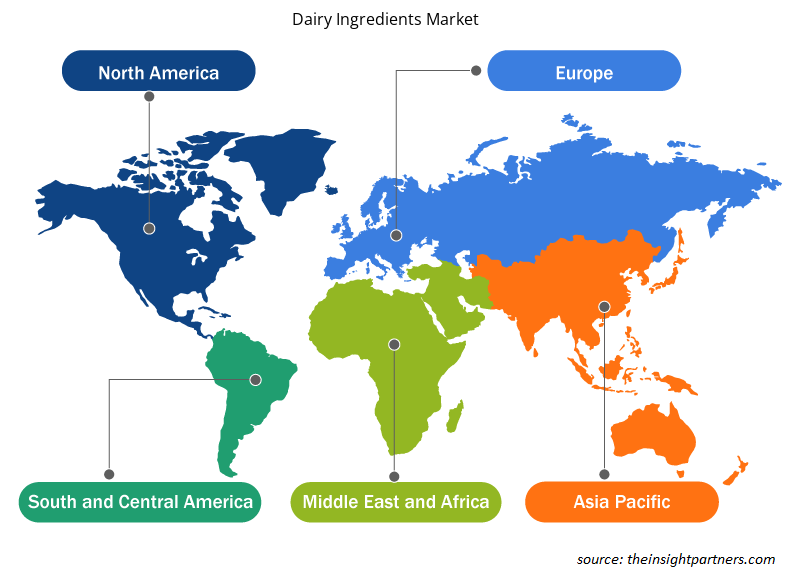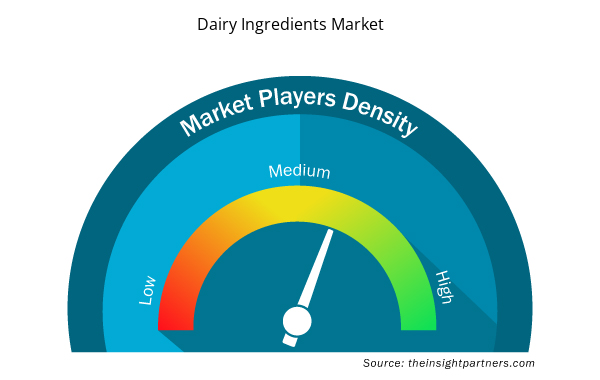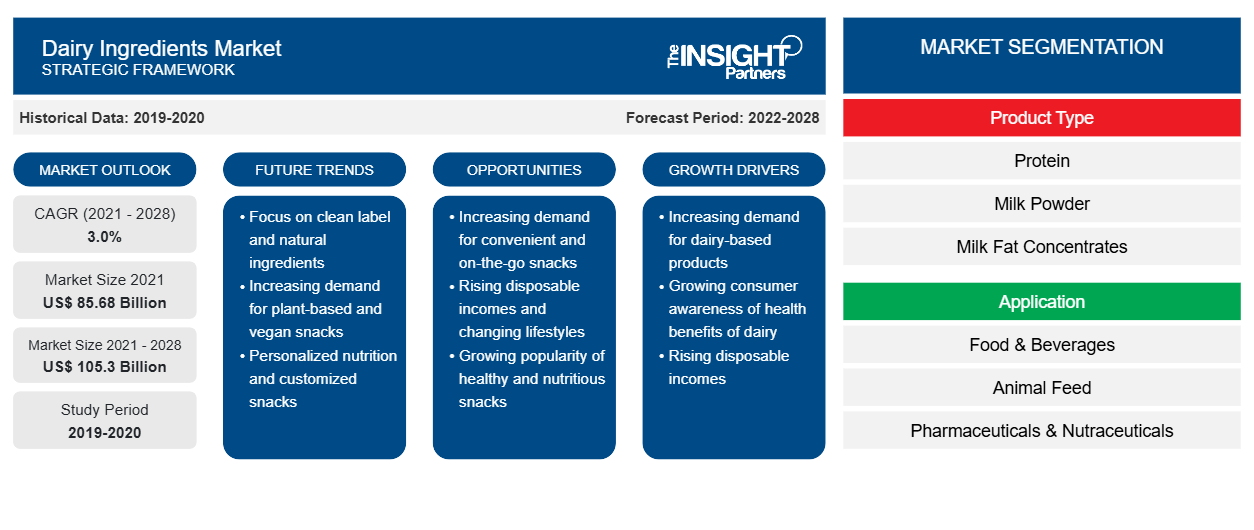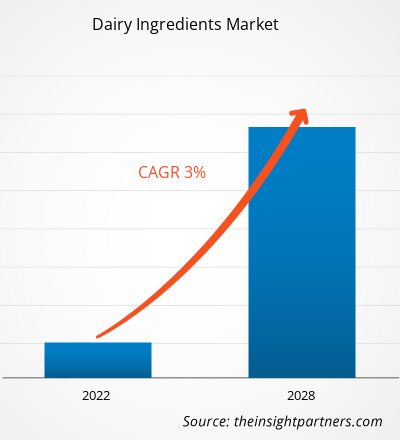El mercado de ingredientes lácteos se valoró en 85.684,15 millones de dólares en 2021 y se proyecta que alcance los 105.295,16 millones de dólares en 2028. Se espera que crezca a una CAGR del 3,0% entre 2021 y 2028.
Los ingredientes lácteos son una fuente rica de proteínas, aminoácidos, carbohidratos, minerales, vitaminas y probióticos . Los ingredientes lácteos se utilizan en diversos alimentos y bebidas, incluidos productos de panadería, confitería, helados, productos lácteos, postres, mezclas de especias y mezclas secas para hornear. Las proteínas lácteas se utilizan en suplementos proteicos y alimentos funcionales. Además, los ingredientes lácteos también se utilizan en productos de cuidado personal, ya que proporcionan hidratación a la piel y al cabello. Además, las proteínas lácteas se utilizan en la alimentación animal para fortificar los alimentos y satisfacer los requisitos nutricionales de los animales de granja.
En 2020, la región de Asia y el Pacífico tuvo la mayor participación en el mercado mundial de ingredientes lácteos, mientras que se espera que el mercado de Oriente Medio y África crezca a la tasa de crecimiento anual compuesta más rápida durante el período de pronóstico. La India es uno de los mayores productores de lácteos de la región. Según la Organización de las Naciones Unidas para la Alimentación y la Agricultura (FAO), la India representa el 22 % de la producción mundial de leche. La presencia de una industria láctea bien establecida en la región es uno de los principales factores que impulsan el crecimiento del mercado regional. Además, la creciente demanda de alimentos y bebidas funcionales y suplementos proteicos debido al creciente enfoque en la salud y el bienestar también son factores importantes que impulsan el crecimiento del mercado de ingredientes lácteos de Asia y el Pacífico.
Personalice este informe según sus necesidades
Obtendrá personalización en cualquier informe, sin cargo, incluidas partes de este informe o análisis a nivel de país, paquete de datos de Excel, así como también grandes ofertas y descuentos para empresas emergentes y universidades.
- Obtenga las principales tendencias clave del mercado de este informe.Esta muestra GRATUITA incluirá análisis de datos, desde tendencias del mercado hasta estimaciones y pronósticos.
Impacto de la pandemia de COVID-19 en el mercado de ingredientes lácteos
La pandemia de COVID-19 ha afectado a muchas industrias, incluida la industria de alimentos y bebidas. La pandemia creó dificultades operativas debido a los cierres, cierres comerciales e interrupciones de la cadena de suministro. La industria láctea también se vio afectada debido a la escasez de mano de obra y materia prima. Sin embargo, debido a una mayor conciencia sobre la salud y el fitness, la demanda de alimentos y bebidas funcionales aumentó, lo que ofreció oportunidades de crecimiento positivas para el mercado de ingredientes lácteos . Además, la necesidad de suplementos dietéticos también aumentó debido a la creciente preferencia por productos que estimulan la inmunidad. Este factor también impulsó positivamente el crecimiento del mercado. Además, se proyecta que el aumento de las tasas de vacunación, la reactivación de las actividades de fabricación y la relajación de las regulaciones gubernamentales influyan positivamente en el mercado mundial de ingredientes lácteos durante el período de pronóstico.
Perspectivas del mercado
El crecimiento de la industria láctea impulsa el mercado de ingredientes lácteos
La industria láctea mundial está experimentando un crecimiento notable. Según la Organización de las Naciones Unidas para la Alimentación y la Agricultura (FAO), la producción mundial de leche ascendió a 928 millones de toneladas en 2021. El aumento de la población y los cambios en la dieta de las personas están impulsando potencialmente el crecimiento de la industria láctea. Además, la rápida urbanización, el aumento de la renta disponible y la creciente preferencia por alimentos nutritivos y ricos en proteínas también están impulsando el desarrollo de la industria láctea. Además, la industria láctea está experimentando una transformación tecnológica. Los fabricantes utilizan tecnologías emergentes, como blockchain, robótica y dispositivos habilitados con GPS, para optimizar la producción láctea. Estos factores están impulsando el crecimiento de la industria láctea, lo que probablemente impulsará el crecimiento del mercado de ingredientes lácteos durante el período de pronóstico.
Información sobre el tipo de producto
Según el tipo de producto, el mercado mundial de ingredientes lácteos se segmenta en proteínas, leche en polvo, concentrados de grasa láctea, lactosa y derivados de la lactosa, entre otros. Se espera que el segmento de proteínas registre un crecimiento significativo durante el período de pronóstico 2021-2028. La caseína y las proteínas del suero son las principales proteínas que se encuentran en la leche. La caseína se usa ampliamente en productos de nutrición infantil y alimentos para bebés. Las proteínas del suero se utilizan para fabricar suplementos proteicos. Las proteínas del suero también se utilizan en alimentos y bebidas funcionales con fines de fortificación. La creciente demanda de alimentos ricos en proteínas está impulsando la necesidad de proteínas lácteas. Además, la creciente demanda de proteínas lácteas para fabricar alimentos infantiles debido a una mayor conciencia sobre la nutrición infantil específica también está impulsando el crecimiento del segmento.
Información sobre aplicaciones
Según la aplicación, el mercado de ingredientes lácteos se segmenta en alimentos y bebidas, productos farmacéuticos y nutracéuticos, alimentos para animales y cuidado personal. El segmento de alimentos y bebidas representó la mayor participación de mercado en 2020. Los ingredientes lácteos se utilizan ampliamente en diversos alimentos y bebidas, incluidos pan, pasteles, bollería, muffins, helados, chocolates, queso y crema. La industria de alimentos y bebidas en rápido crecimiento debido al aumento de los ingresos disponibles, la rápida urbanización, la creciente inclinación hacia la salud y el fitness y la creciente demanda de alimentos preparados, son los factores clave que impulsan el crecimiento del mercado de ingredientes lácteos. Además, también se espera que la creciente demanda de proteínas lácteas de la industria nutracéutica impulse el crecimiento del segmento en los próximos años.
Algunos de los actores que operan en el mercado de ingredientes lácteos incluyen Agropur, Arla Foods Ingredients Group P/S, Lactalis Ingredients, Frieslandcampina, Saputo Inc., Fonterra Co-Operative Group Limited, Kerry, Amco Proteins, Prolactal y Glanbia Ireland, entre otros.
Perspectivas regionales del mercado de ingredientes lácteos
Los analistas de Insight Partners explicaron en detalle las tendencias y los factores regionales que influyen en el mercado de ingredientes lácteos durante el período de pronóstico. Esta sección también analiza los segmentos y la geografía del mercado de ingredientes lácteos en América del Norte, Europa, Asia Pacífico, Oriente Medio y África, y América del Sur y Central.

- Obtenga datos regionales específicos para el mercado de ingredientes lácteos
Alcance del informe de mercado de ingredientes lácteos
| Atributo del informe | Detalles |
|---|---|
| Tamaño del mercado en 2021 | US$ 85,68 mil millones |
| Tamaño del mercado en 2028 | US$ 105,3 mil millones |
| CAGR global (2021-2028) | 3.0% |
| Datos históricos | 2019-2020 |
| Período de pronóstico | 2022-2028 |
| Segmentos cubiertos | Por tipo de producto
|
| Regiones y países cubiertos | América del norte
|
| Líderes del mercado y perfiles de empresas clave |
|
Densidad de actores del mercado de ingredientes lácteos: comprensión de su impacto en la dinámica empresarial
El mercado de ingredientes lácteos está creciendo rápidamente, impulsado por la creciente demanda de los usuarios finales debido a factores como la evolución de las preferencias de los consumidores, los avances tecnológicos y una mayor conciencia de los beneficios del producto. A medida que aumenta la demanda, las empresas amplían sus ofertas, innovan para satisfacer las necesidades de los consumidores y aprovechan las tendencias emergentes, lo que impulsa aún más el crecimiento del mercado.
La densidad de actores del mercado se refiere a la distribución de las empresas o firmas que operan dentro de un mercado o industria en particular. Indica cuántos competidores (actores del mercado) están presentes en un espacio de mercado determinado en relación con su tamaño o valor total de mercado.
Las principales empresas que operan en el mercado de ingredientes lácteos son:
- Ingrediente FrieslandCampina.
- Grupo Cooperativo Fonterra Limitada
- Grupo de ingredientes de Arla Foods P/S
- Ingredientes de Lactalis
- AGROPUR
Descargo de responsabilidad : Las empresas enumeradas anteriormente no están clasificadas en ningún orden particular.

- Obtenga una descripción general de los principales actores clave del mercado de ingredientes lácteos
Informe Destacado
- Tendencias progresivas de la industria en el mercado de ingredientes lácteos para ayudar a los actores a desarrollar estrategias efectivas a largo plazo
- Estrategias de crecimiento empresarial adoptadas por los mercados desarrollados y en desarrollo
- Análisis cuantitativo del mercado de ingredientes lácteos de 2019 a 2028
- Estimación de la demanda mundial de ingredientes lácteos
- Análisis de las cinco fuerzas de Porter para ilustrar la eficacia de los compradores y proveedores que operan en la industria
- Avances recientes para comprender el escenario competitivo del mercado
- Tendencias y perspectivas del mercado, así como factores que impulsan y restringen el crecimiento del mercado de ingredientes lácteos
- Asistencia en el proceso de toma de decisiones destacando las estrategias de mercado que sustentan el interés comercial, lo que conduce al crecimiento del mercado.
- El tamaño del mercado de ingredientes lácteos en varios nodos
- Descripción detallada y segmentación del mercado, así como la dinámica de la industria de ingredientes lácteos.
- Tamaño del mercado de ingredientes lácteos en varias regiones con oportunidades de crecimiento prometedoras
- Análisis histórico (2 años), año base, pronóstico (7 años) con CAGR
- Análisis PEST y FODA
- Tamaño del mercado Valor/volumen: global, regional, nacional
- Industria y panorama competitivo
- Conjunto de datos de Excel



Report Coverage
Revenue forecast, Company Analysis, Industry landscape, Growth factors, and Trends

Segment Covered
This text is related
to segments covered.

Regional Scope
North America, Europe, Asia Pacific, Middle East & Africa, South & Central America

Country Scope
This text is related
to country scope.
Preguntas frecuentes
With the rapid growth of the dairy industry, the demand for dairy ingredients such as milk powder, lactose and its derivatives, milk protein, etc., is also growing. surging dairy production, the dairy ingredients market is also projected to register a notable growth over the forecast period.
Asia-Pacific accounted for the largest share of the global dairy ingredients market. The surge in demand for dairy ingredients in the food & beverage and nutraceutical industry to drive the dairy ingredients market in the region.
The dairy ingredients are a major constituent of nutritious food and supplements. It gets widely used in probiotic foods, protein supplements. Whey protein is often sold as a protein supplement, and it has been associated to a variety of health benefits. Due to these properties, manufacturers of pharmaceutical and nutraceutical products frequently employ dairy ingredients in their products.
Dairy ingredients have a wide range of applications across several end-use industries including food and beverage, pharmaceuticals and nutraceuticals, personal care, and animal feed is expected to create lucrative opportunities for dairy ingredients market in the coming years.
Based on application, the food and beverage segment accounted for the largest revenue share as the dairy ingredients essentially thrive on the wider functional benefits that these ingredients confer, in terms of high quality, safety, and nutrition of the processed food products. Processed food products include various categories, such as baked products, confectionary, and beverages.
The major players operating in the global dairy ingredients market are FrieslandCampina Ingredient., Fonterra Co-operative Group Limited, Arla Foods Ingredients Group P/S, Lactalis Ingredients, AGROPUR, Saputo Inc., Kerry Group, AMCO Proteins, PROLACTAL, Glanbia Ireland.
Trends and growth analysis reports related to Food and Beverages : READ MORE..
The List of Companies - Dairy Ingredients Market
- FrieslandCampina Ingredient.
- Fonterra Co-operative Group Limited
- Arla Foods Ingredients Group P/S
- Lactalis Ingredients
- AGROPUR
- Saputo Inc.
- Kerry Group
- AMCO Proteins
- PROLACTAL
- Glanbia Ireland
The Insight Partners performs research in 4 major stages: Data Collection & Secondary Research, Primary Research, Data Analysis and Data Triangulation & Final Review.
- Data Collection and Secondary Research:
As a market research and consulting firm operating from a decade, we have published and advised several client across the globe. First step for any study will start with an assessment of currently available data and insights from existing reports. Further, historical and current market information is collected from Investor Presentations, Annual Reports, SEC Filings, etc., and other information related to company’s performance and market positioning are gathered from Paid Databases (Factiva, Hoovers, and Reuters) and various other publications available in public domain.
Several associations trade associates, technical forums, institutes, societies and organization are accessed to gain technical as well as market related insights through their publications such as research papers, blogs and press releases related to the studies are referred to get cues about the market. Further, white papers, journals, magazines, and other news articles published in last 3 years are scrutinized and analyzed to understand the current market trends.
- Primary Research:
The primarily interview analysis comprise of data obtained from industry participants interview and answers to survey questions gathered by in-house primary team.
For primary research, interviews are conducted with industry experts/CEOs/Marketing Managers/VPs/Subject Matter Experts from both demand and supply side to get a 360-degree view of the market. The primary team conducts several interviews based on the complexity of the markets to understand the various market trends and dynamics which makes research more credible and precise.
A typical research interview fulfils the following functions:
- Provides first-hand information on the market size, market trends, growth trends, competitive landscape, and outlook
- Validates and strengthens in-house secondary research findings
- Develops the analysis team’s expertise and market understanding
Primary research involves email interactions and telephone interviews for each market, category, segment, and sub-segment across geographies. The participants who typically take part in such a process include, but are not limited to:
- Industry participants: VPs, business development managers, market intelligence managers and national sales managers
- Outside experts: Valuation experts, research analysts and key opinion leaders specializing in the electronics and semiconductor industry.
Below is the breakup of our primary respondents by company, designation, and region:

Once we receive the confirmation from primary research sources or primary respondents, we finalize the base year market estimation and forecast the data as per the macroeconomic and microeconomic factors assessed during data collection.
- Data Analysis:
Once data is validated through both secondary as well as primary respondents, we finalize the market estimations by hypothesis formulation and factor analysis at regional and country level.
- Macro-Economic Factor Analysis:
We analyse macroeconomic indicators such the gross domestic product (GDP), increase in the demand for goods and services across industries, technological advancement, regional economic growth, governmental policies, the influence of COVID-19, PEST analysis, and other aspects. This analysis aids in setting benchmarks for various nations/regions and approximating market splits. Additionally, the general trend of the aforementioned components aid in determining the market's development possibilities.
- Country Level Data:
Various factors that are especially aligned to the country are taken into account to determine the market size for a certain area and country, including the presence of vendors, such as headquarters and offices, the country's GDP, demand patterns, and industry growth. To comprehend the market dynamics for the nation, a number of growth variables, inhibitors, application areas, and current market trends are researched. The aforementioned elements aid in determining the country's overall market's growth potential.
- Company Profile:
The “Table of Contents” is formulated by listing and analyzing more than 25 - 30 companies operating in the market ecosystem across geographies. However, we profile only 10 companies as a standard practice in our syndicate reports. These 10 companies comprise leading, emerging, and regional players. Nonetheless, our analysis is not restricted to the 10 listed companies, we also analyze other companies present in the market to develop a holistic view and understand the prevailing trends. The “Company Profiles” section in the report covers key facts, business description, products & services, financial information, SWOT analysis, and key developments. The financial information presented is extracted from the annual reports and official documents of the publicly listed companies. Upon collecting the information for the sections of respective companies, we verify them via various primary sources and then compile the data in respective company profiles. The company level information helps us in deriving the base number as well as in forecasting the market size.
- Developing Base Number:
Aggregation of sales statistics (2020-2022) and macro-economic factor, and other secondary and primary research insights are utilized to arrive at base number and related market shares for 2022. The data gaps are identified in this step and relevant market data is analyzed, collected from paid primary interviews or databases. On finalizing the base year market size, forecasts are developed on the basis of macro-economic, industry and market growth factors and company level analysis.
- Data Triangulation and Final Review:
The market findings and base year market size calculations are validated from supply as well as demand side. Demand side validations are based on macro-economic factor analysis and benchmarks for respective regions and countries. In case of supply side validations, revenues of major companies are estimated (in case not available) based on industry benchmark, approximate number of employees, product portfolio, and primary interviews revenues are gathered. Further revenue from target product/service segment is assessed to avoid overshooting of market statistics. In case of heavy deviations between supply and demand side values, all thes steps are repeated to achieve synchronization.
We follow an iterative model, wherein we share our research findings with Subject Matter Experts (SME’s) and Key Opinion Leaders (KOLs) until consensus view of the market is not formulated – this model negates any drastic deviation in the opinions of experts. Only validated and universally acceptable research findings are quoted in our reports.
We have important check points that we use to validate our research findings – which we call – data triangulation, where we validate the information, we generate from secondary sources with primary interviews and then we re-validate with our internal data bases and Subject matter experts. This comprehensive model enables us to deliver high quality, reliable data in shortest possible time.


 Obtenga una muestra gratuita de este informe
Obtenga una muestra gratuita de este informe